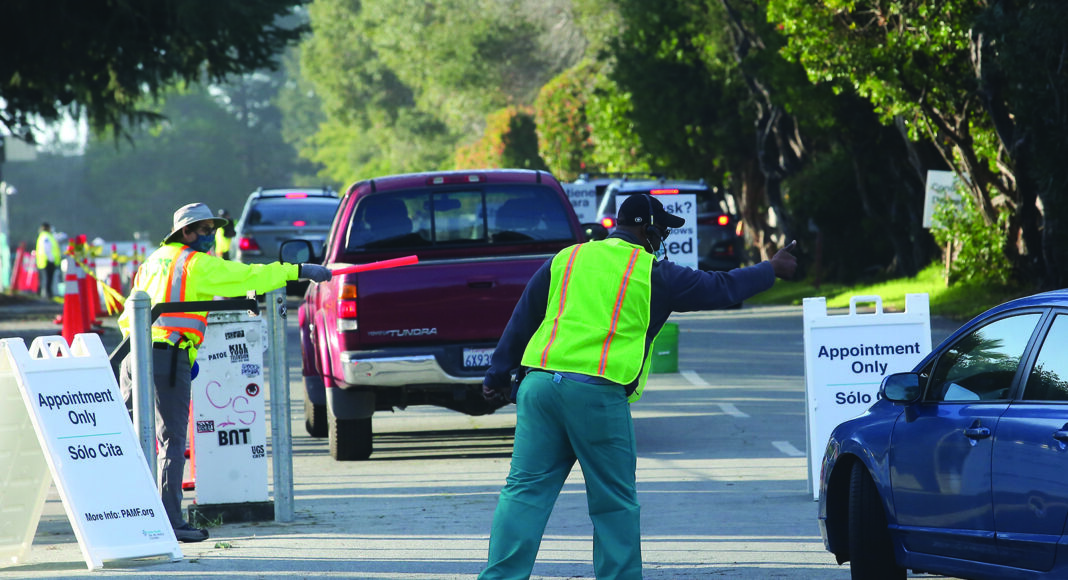No communities in Santa Cruz County qualify for the California Department of Public Health’s vaccine equity plan, which Gov. Gavin Newsom last week pitched as a way for the state to prioritize disadvantaged and Latinx communities that have seen a disproportionate impact from the pandemic.
Under the plan, the state was to set aside 40% of its vaccines for communities in the lowest quartile of its Healthy Places Index (HPI). The HPI provides overall scores and data that predict life expectancy and compare community conditions that shape health such as education levels and income, among other things.
In Santa Cruz County, three census tracts making up most of Watsonville fall in the lowest quartile of the HPI map. The census tract that contains neighboring Pajaro, which is under Monterey County’s jurisdiction just over the Pajaro River bridge, also falls in that quartile.
The trouble, Santa Cruz County spokesman Jason Hoppin says, is the state is determining which communities qualify for the plan through zip codes, and not census tracts, as the state’s interactive HPI map does.
Hoppin said county health officials were set to talk to state leadership about why the 95076 zip code—which along with hard-hit Watsonville also includes Pajaro Dunes, La Selva Beach, Corralitos and Aptos-Larkin Valley—was not included in the state’s plan, and what that could mean for its vaccine allocations.
That zip code was placed in the second-lowest quartile designation, according to a data sheet obtained by GT that shows in which HPI quartile every California zip code stands, and does not qualify for the state’s equity plan.
It is still unknown what that will mean for the county’s vaccine allocation, says Santa Cruz County Supervisor Zach Friend, who represents parts of the 95076 zip code in the second district. Friend, however, did say that the state has been willing to adjust its mandates in the past, and that the California Department of Public Health knows about the discrepancy after holding a meeting with the Bay Area health officers group on Monday.
“At this point there isn’t a resolution but the concern has been raised,” he said. “It did sound like there was a commitment from the state to at least look into what these concerns are.”
Friend said the state’s decision to use the broader zip code designation instead of census tracts, as it has throughout the pandemic, is an “absolute U-turn” from its previous policies.
“Hopefully they’ll see that this actually ends up impacting the exact same populations that they’re trying to help with this policy and that a zip code is too broad,” he said. “We need to move back toward a census tract designation so that areas like Watsonville can continue to receive the allotment that it needs.”
Santa Cruz County officials were not the only ones concerned with being left out of the state’s plan. Over the hill, Bay Area lawmakers were ready to hold a press conference to call on state officials to alter the plan, but abruptly canceled the gathering to instead reportedly meet with those representatives.
“The Governor’s Office has expressed a committed (sic) to providing a more formal response to the concerns expressed by Bay Area communities on the vaccine equity rollout issues within the next 24 hours,” State Senator Dave Cortese (D-San Jose) said in a statement. “We are working collaboratively with them and are optimistic that hard-hit areas in the Bay Area that were overlooked will now be included in the state’s prioritization.
“Not every community has felt the effects of this pandemic equally. We need targeted efforts to address the longstanding racial and economic disparities that have been only intensified by Covid-19.”
Only 2% of Bay Area residents qualify for the state’s plan. That’s despite the fact that the Bay Area makes up 20% of California’s population, and that several communities have been deeply impacted by the pandemic both economically and health-wise.
Santa Clara County, for example, has no zip codes that qualify for the plan, according to a data sheet obtained by this publication that shows in which HPI quartile every California zip code stands.
Cortese said the state should instead recalibrate its definition of “hard-hit Covid-19 impacted communities based on census tract data from counties so that no hard-hit census tracts are left behind.”
According to state data, 40% of Covid-19 cases and deaths have occurred in the lowest quartile of the HPI. The rate of infections for households making less than $40,000 per year (11.3%) is more than double that of households with an income of $120,000 or more (5.2%). At the same time, California’s wealthiest populations are being vaccinated at nearly twice the rate of its most vulnerable populations.
Newsom last week also emphasized the toll the pandemic has had on Latinx communities. According to state data, about 55% of the state’s 3.5 million cases have been in people of Latinx descent. Those Californians have also accounted for roughly 46% of the state’s 54,000 Covid-19-related deaths.
Local data closely mirrors those numbers. About 52% of the county’s roughly 14,800 cases have been reported in Watsonville. In addition, Latinx residents make up 54% of cases when county data is filtered by ethnicity.
The county has administered more than 96,500 vaccinations, according to data presented by the state as of Monday, and 17.4% of those vaccines have gone to Latinx residents. In addition, multi-race residents have received about 18.3% of the vaccines in Santa Cruz County. White residents have received 43.8% of the county’s vaccines.













